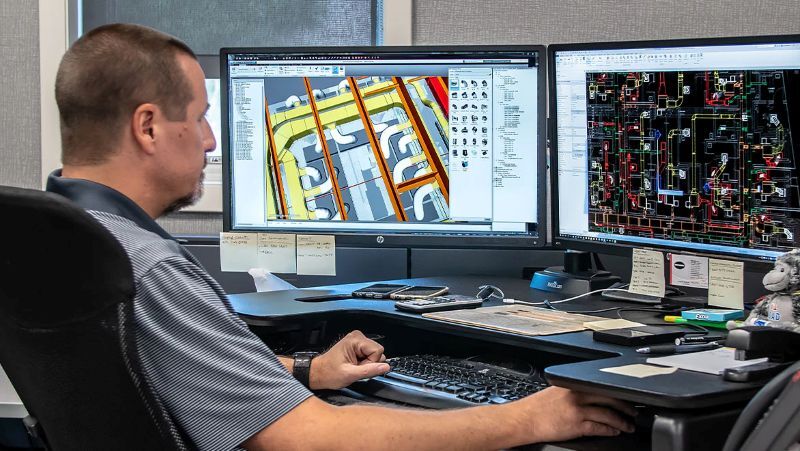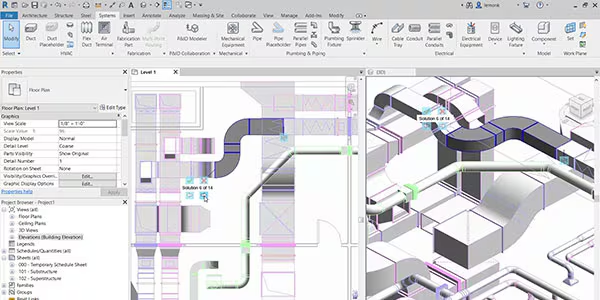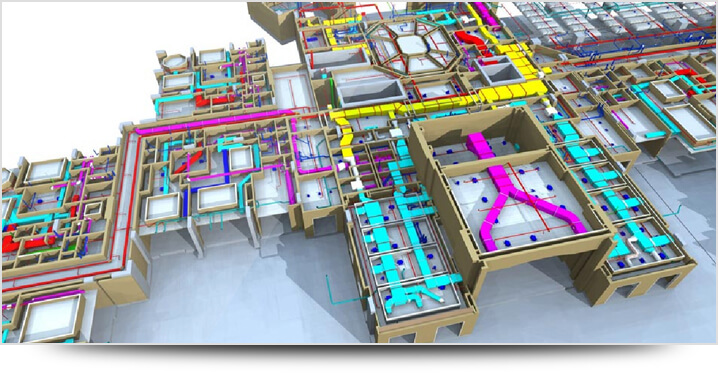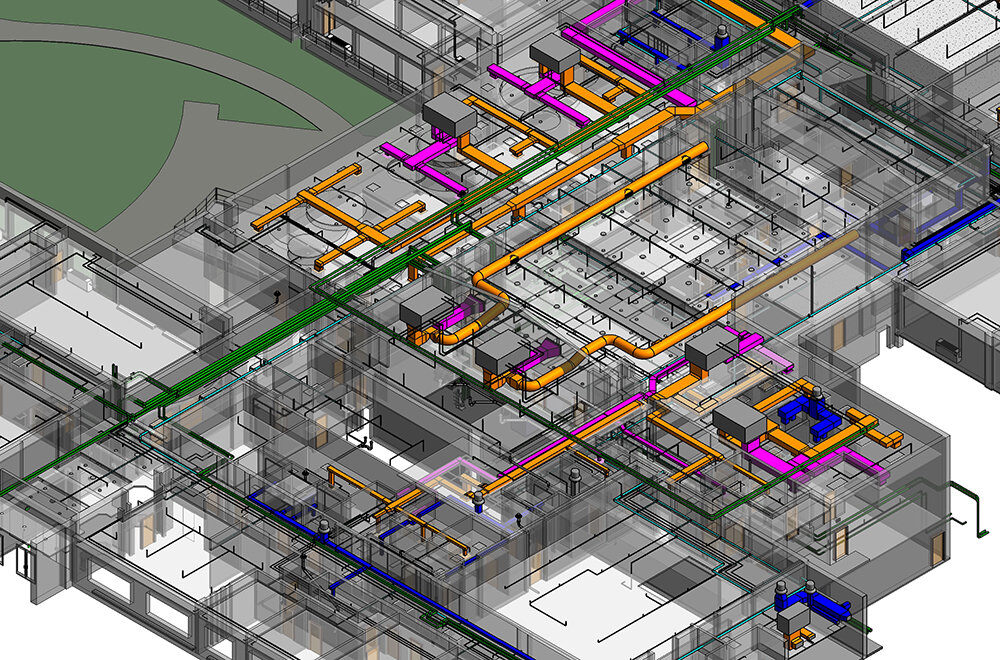
BIM is dawning a momentous shift in the manner Architecture, Engineering, and Construction (AEC) projects operate. Ever since it gained momentum in the early 2000s, there has been no looking back for the industry. BIM adoption has only witnessed an upward trajectory due to its wide assortment of benefits, such as faster design and construction processes, efficiency, and ease of communication.
In the Mechanical, Electrical, and Plumbing (MEP) sector, BIM has become synonymous with modern building design. It enables clash detection, seamless coordination, and smart system design that offers more room for integrating concepts of sustainability and futuristic architecture. As the layers of building services become denser and more intertwined, BIM can be leveraged to make construction more precise and resourceful.
Why Do MEP Engineers Need Advanced BIM Training?
MEP Engineering is a highly technical subject that demands attention to detail and accuracy in execution. This is where BIM can be used to streamline processes, avoid irregularities, and ease communications. So, let’s take a deep dive into how BIM can help MEP engineers.
1. Project Efficiency
Advanced BIM skills allow professionals to streamline design, detect clashes early, and reduce rework on-site. With intelligent modeling and data-driven simulations, you can deliver coordinated and error-free designs faster. This helps save both time and money.
2.Team Collaboration
BIM fosters real-time coordination across various project verticals. Engineers trained in advanced workflows can contribute more effectively, avoiding costly misalignments and improving overall project harmony.
3. Competitive Edge
Top construction firms are on the lookout for individuals who are skilled in BIM. Having mastery in software like Revit, Dynamo, Trimble Connect, and BIM 360 sets you apart in a saturated job market.
4. Better-Paying Jobs
BIM expertise directly translates to higher earning potential. Employers offering BIM MEP jobs value individuals who can lead coordination, manage data-rich models, and drive digital delivery.
5. Future-Proof Your Career
As the industry shifts toward automation, prefabrication, 3D printing, and digital twins, staying relevant means staying ahead. BIM training arms you with the right mindset, essential for leading the AEC industry from the forefront.
What Role Does BIM Play in MEP Design?

BIM MEP serves as an integral cog in the machinery of multi-dimensional AEC projects. It not only improves structural integrity but also enhances the overall built infrastructure. Here’s a closer look at how BIM plays a role in elevating MEP services.
1. 3D Visualization
Allows MEP engineers to design and visualize mechanical, electrical, and plumbing systems in a coordinated 3D environment.
2. Clash Detection and Resolution
Identifies spatial conflicts between MEP components and architectural/structural elements early in the design phase.
3. Improved Coordination
Facilitates seamless collaboration with architects, structural engineers, and contractors, ensuring alignment of all building systems.
4. Accurate Quantity Takeoffs
Provides precise material estimates and real-time updates for better budgeting and resource planning.
5. Enhanced Design Efficiency
Reduces manual errors through parametric modelling and intuitive design. This speeds up the overall project timeline.
6. Simulation and Analysis Capabilities
Provides load calculations, energy analysis, and performance optimization for MEP systems.
7. Support for Modular Construction
BIM models are used to fabricate MEP components off-site, improving construction speed and quality.
8. Lifecycle Management and Predictive Maintenance
Supplies detailed asset data that supports facility management and long-term maintenance post-construction.
Top 5 BIM Software for MEP Engineers

BIM MEP software is a tool for bringing ambitious architectural visions to life. They help align your ideas with practicality, while assuring timely and definite results. Mentioned below are the key software programs you can explore.
1. Revit MEP
Revit MEP is the most popular and sought-after BIM software for MEP professionals. It offers everything from documentation to clash detection and system coordination in a centralized platform. Additionally, its parametric components and data-rich environment make it essential for creating detailed and accurate service layouts.
2. Navisworks
Navisworks complements Revit by offering powerful tools for model aggregation, clash detection, and 4D simulation. It’s particularly useful in the coordination phase of projects, where MEP systems often intersect with architectural and structural components. By importing models from various software formats, Navisworks gives engineers a holistic view of the project and helps identify and resolve conflicts before construction begins.
3. Dynamo
Dynamo is a visual programming tool that integrates with Revit to automate repetitive tasks and create complex logic-based systems. For MEP engineers, this means the ability to generate custom scripts for automating duct sizing, pipe routing, or even parameter modifications across large models.
4. Allplan
Allplan is a versatile MEP BIM modeling tool, known for its precision and flexibility. While often associated with structural design, its MEP capabilities are growing in strength. The software offers multidisciplinary collaboration and interoperability, which is crucial for projects of scale.
5. Tekla Structures
Similar to Allplan, Tekla Structures is renowned for its strength in structural BIM, but it also plays a supporting role in MEP coordination. Its ability to manage highly detailed models makes it ideal for projects involving prefabricated MEP components or complex installations.
What Will You Learn in Novatr’s MEP BIM Course?
Novatr offers industry-specific upskilling programs for architects, civil engineers, as well as MEP engineers. Their courses are tailored to suit the specific needs of each of these professions and equip them to handle grassroots challenges. Let’s explore the curriculum for Novatr’s BIM Course for MEP Engineers can help you:
- Introduction to BIM
- MEP Fundamentals
- BIM documentation and presentation
- Information management and modeling
- Scheduling and Audits
- Industry standards
- Collaboration and clash detection
- Capstone projects
The curriculum also offers scope for specialization for niche upskilling, such as RCC modeling, visual programming, and project strategy.
How Does Mentorship Help MEP Engineers Excel in BIM?
Mentorship is one of the most crucial attributes of upskilling that shapes a learner. It moulds their character and approach towards work, which defines their career trajectory. Here’s how BIM MEP engineers can leverage mentorship:
- Guidance from experienced professionals helps simplify complex BIM processes and workflows, making it easier for engineers to upskill quickly.
- First-hand insights from mentors into real projects reveal best practices and mistakes that go beyond theoretical knowledge.
- Regular feedback and hands-on support boost assurance in handling models, managing data, and coordinating systems.
- Learning how to navigate interdisciplinary teamwork becomes easier through observed examples and shared experiences.
- Access to industry networks, certification advice, and professional development tips can open new career paths.
- Staying updated with evolving BIM tools and industry trends becomes second nature when learning alongside someone with experience.
How Does BIM Training Boost MEP Career Opportunities?
BIM is not just another skill on your resume or LinkedIn profile. It is a skill that opens doors to new possibilities in the professional realm. So, let’s indulge in the key advantages of the BIM MEP course for engineers.
1. You Become Irreplaceable
BIM-trained MEP engineers are more than just designers. They’re collaborators who understand how to integrate their systems within a coordinated digital model. This cross-disciplinary understanding makes you a vital asset in multidisciplinary teams, especially in large-scale or complex projects.
2. Stand Out in the Job Market
With BIM increasingly mandated across public and private projects, MEP BIM courses help you become qualified for such roles. Having advanced BIM skills on your resume makes you more attractive to employers and opens doors to specialized positions.
3. Work Smarter, Not Harder
BIM streamlines workflows. From automated calculations to clash detection, trained MEP engineers can avoid costly rework, reduce errors, and deliver faster results. This increases efficiency but also builds your reputation as someone who gets things done right the first time.
4. Unlock Higher Earning Potential
Advanced BIM skills often command better compensation. Whether you're managing federated models or handling data-rich documentation, your ability to drive project success translates directly into value and money.
How Is Novatr’s BIM MEP Course Better Than Others?
Novatr’s BIM course for MEP engineers is not your regular off-the-shelf program. It is a course that prepares students to become industry leaders. While the platform provides a holistic course curriculum, it also offers a structured career plan that sets you up for success. Here’s how:
- Explore 12 + BIM software with industry applications
- Live support and query assistance
- Learn from 200+ BIM professionals working in leading AEC companies
- Leverage cohort-based learning with a 1:20 mentor-to-student ratio
- 80+ hours of weekly live sessions for revisions and practice
- Receive certification from Autodesk, Novatr, and NSDC
- Work on multiple ISO 19650 and RIBA-certified projects
- Placement assistance for securing jobs
Why Should MEP Engineers Upskill with Novatr?
By signing up for Novatr’s BIM MEP course, participants can transition into tech-relevant roles such as a BIM Mechanical Engineer, BIM Modeller, and BIM consultant. So, if you want to build a resume that reckons with the future of work, here’s why MEP professionals should upskill with Novatr.
- Learn BIM workflows tailored specifically for MEP systems covering HVAC, electrical, plumbing, and fire protection design.
- Gain practical experience with tools like Revit, Navisworks, Dynamo, and more, through guided projects and real-world simulations.
- Get one-on-one guidance from experienced BIM professionals working in leading global firms.
- Build a portfolio that aligns with international standards and makes you competitive in both local and overseas job markets.
- Access resume reviews, mock interviews, and direct connections to hiring partners looking for skilled MEP BIM professionals.
Conclusion
BIM is set to change the nature of work for MEP professionals. With precision and efficiency at its heart, BIM can truly change the game for large-scale projects of global significance. This is why MEP engineers need to embrace BIM skills as part of their everyday workflows. Now, if you are looking for courses that can help you ride this wave of change, we advise you to enroll in online programs. These courses allow you to learn from anywhere, anytime, and are far more economical than traditional university courses.
For this purpose, we suggest you explore the BIM Professional Course for MEP Engineers by Novatr. It is one of the most comprehensive programs that offers a well-rounded knowledge of BIM processes. The course curriculum is designed to equip students with industry-relevant knowledge, delivered via practicing professionals from top 1% global AEC firms. These mentors bring their expertise and experience to the table in the form of case studies and hands-on learning. Novatr also offers aid for job placement by helping its learners groom their theoretical and practical BIM skills.
Explore the course today!
Visit our Resources Page to learn more about BIM in MEP Design.
Was this content helpful to you





.png)

.png)
